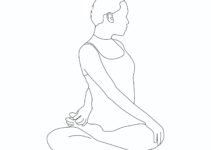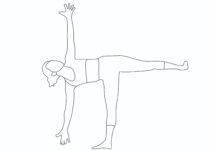What do you mean by triangle pose yoga?
Triangle pose yoga is also known as Trikonasana, a crucial standing pose. Trikonasana is a Sanskrit word comprised of Tri means ‘three’, which means ‘angle’, and asana means ‘yoga pose’. As the asana resembles the triangle made by the trunk, arms and legs, it is called Trikonasana. Doing triangle pose steps is not tricky; it only needs some flexibility and stamina. The yoga pose is known for numerous health benefits, which give it a unique position in the world of yoga asanas. Being a yoga practitioner, I have been regularly practising this yoga pose for a long time, and I recommend everyone to include it in their yoga module. The yoga pose is known for 3 ‘S’: Stability, Strength, and stamina. Triangle pose yoga affects you from toes to fingers and accordingly benefits the various organs of the body. Though it is full of benefits, it is also associated with some precautions.

How to do triangle pose yoga: steps and instructions
To extract the benefits of the triangle pose, one has to know how to practice it properly.
- Inhale, raise both arms sideways up to shoulder level and keep about 2 to 3 feet distance between your legs.
- Turn the right foot towards the right side.
- Exhale, slowly bend to the right side and place the right-hand fingers. Just behind the right foot.
- The left arm is straight in line with the right arm.
- Turn the left palm forward.
- Turn your head and gaze at the tip of the left middle finger.
- Initially, maintain the yoga pose for 30 seconds with normal breathing and increase the time gradually.
- The same procedure may be done from the left side.
9 Impressive health benefits of triangle pose yoga
- Weight loss: One of the essential benefits of practising trikonasana is weight loss or the burning of fat from the stomach, waist, thighs, and back. How it works: If you want to reduce your weight naturally, do this yoga pose regularly for one week. While practising the asana, keep a few things in mind: try to increase the time duration of the pose or maintain it as long as you can, and focus on stretching & twisting muscles along with breathing. You will get a wonderful result in one week. Therefore, it should especially include those who face the problems of obesity and weight.
- Improves flexibility: The yoga pose improves flexibility as practising the pose gives adequate muscular and nervous stretching.
- Increase height: The pose gives desirable stretch to the entire body. The practice of it helps to energise the muscles of the whole body and is considered one of the most effective yoga poses to increase height in growing children.
- Leg deformities: The asana tones up the leg muscles and removes stiffness from the legs and hips; thus, it is good to remove deformities from the legs and allow the legs to develop evenly.
- Stress management: The yoga pose aligns and stretches the body. The suitable stretching of different organs helps to release toxins from the body. It also facilitates chest expansion, which leads to more intake of fresh oxygen in the body. Thus, the pose is effective in releasing stress and protecting you from diseases and disorders.
- Best yoga for legs: The yoga helps to give appropriate stretching and strengthen the thighs, knees, and ankles. It is also quite effective for hips, groins, hamstrings, and calves.
- Stability, strength & stamina: This yoga is known for the 3 ‘S’, which means stability, strength, and energy, as it rejuvenates the entire body systems and organs.
- Improves digestion: The pose stimulates the digestive system and stirs the abdominal organs to release enzymes and juices, which are beneficial for digestion and treating constipation.
- Backache and Neck ache: It stretches the entire spinal region along with associated muscles and nerves, which is good for treating backache and neck ache. Also, it solves the problems of spinal health.
Why is the triangle pose unique?
One of the significant advantages of this yoga pose is that it can be practised at any time or place without any formality. It is one of the few yoga poses that can be practised without any preparation. One can do it at home or the office. The long hour sitting at the office leads to irregular blood supply but the practice of the pose helps to encourage blood circulation, flush out toxins, and thus rejuvenate the entire body. The entire nervous system is toned up, especially the spinal nerves. It loosens up the muscles and joints of the whole body.
Breathing and awareness
Breathing is essential not only with triangle poses but, in fact, with all the yoga poses. Inhaling should be done when both arms are raised sideways up to the shoulder level. Do deep breathing while maintaining the yoga pose—Exhale slowly while bending. The same procedure has to be followed by the other side. At least three to five rounds have to be performed.
Triangle pose variations
The different variations of triangle pose are as below:
- Extended Triangle pose (Utthita trikonasana)
- Bound Triangle pose (Baddha trikonasana)
- Revolved Triangle pose (Parivrtta trikonasana)
- Reclining triangle pose (Supta trikonasana)
Triangle pose precautions
- Back pain: The practising of this asana should be strictly avoided in case of severe back pain.
- Migraine: One shouldn’t practice if having migraines.
- Diarrhea: A person who is detected with diarrhoea, high blood pressure, and neck & back injuries shouldn’t perform this asana.
- Dizziness: Those experiencing dizziness shouldn’t look down at the floor during the final stage.
- Cervical spondylosis: In the case of cervical spondylosis, practice but with proper precautions.
- Knee problems: Don’t take the support of your knee while performing this asana as it exerts excess pressure on your knee, which may lead to knee problems.
- Neck pain: If you have neck problems, don’t look up while performing this asana. It is better to gaze straight or look down at the floor.
Joint and muscle actions
There are many joints involved while practising this yoga pose. Spine neutral extension, slight rotation (but not much lateral extension); head axial rotation; upper limb abduction, external rotation. Front leg: hip external rotation, flexion, abduction; knee extension; slight ankle plantarflexion; slight foot pronation. Back leg: hip internal rotation, adduction, extension, knee extension, and foot supination are joint actions involved.





